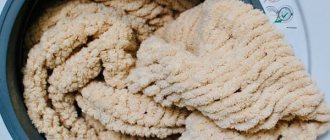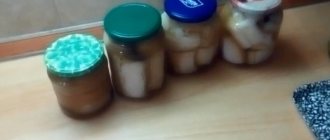Among lovers of cozy things, despite the rather high price, products made from natural angora, a woolen fabric based on the fluff of certain breeds of Angora rabbit or goat, are popular.
And there is a simple explanation for this. Thanks to the properties that create an unsurpassed feeling of warmth and care, clothes made from this fabric are highly valued and occupy a worthy position in the market. When purchasing such a wonderful, delicate and fluffy thing as an angora sweater, the last thing any buyer thinks about is how he will wash and care for it in the future. After all, the product is new and it is literally permeated with airiness and affection, but over time, such a product loses its consumer qualities and original luster. Pills form on the sweater, the fluffiness loses volume, and the fibers stick together and what we see is completely different from what we bought. But don't despair!
Important! If you follow the recommendations described below, you can easily restore the original appearance and sophistication of your favorite item.
What to do if mohair is climbing
Mohair is the name given to yarn made from the wool of Angora goats. Things knitted from angora are very warm, fluffy, and have an attractive appearance. But such products require special delicate care. We tell you how to wash mohair in our article.
Things made from natural angora cost a lot of money. And I must say that it won’t be very difficult to ruin such a thing, especially if you don’t know how to properly care for it, namely wash and dry mohair.
Cleaning methods
- If the wool is not very dirty, you can clean it using the dry cleaning method. But here you need to know that not all chemicals are suitable for cleaning it. Sometimes it is enough to treat a separate stain with a cotton swab and a soap solution warm to 30°C. Then rinse with clean water and blot the area on both sides with a terry towel. After cleaning, the product must be laid out on a cloth for subsequent drying.
IMPORTANT! Do not try to dry the treated wet area with a hair dryer.
- If the item requires special cleaning, you can contact a dry cleaner, but know that they will not give you a guarantee that the wool will not lose its appearance.
- If you decide to wash your mohair yourself, you can use either the hand washing method or the washing machine. But to do this, you need to know a few rules that will prevent you from ruining an expensive item.
Features of washing in a washing machine
Woolen items can also be washed in a washing machine, provided that the wash cycle is delicate. As a rule, the wool is washed manually. The temperature should not be higher than 30°C.
Since mohair products are quite voluminous and fluffy, they should be washed only with delicate liquid detergents that do not contain bleaching components. Why it is not recommended to use regular washing powder because it does not rinse well. To sufficiently rinse the powder from the yarn fibers, you need to add at least a few extra rinses. And this can disrupt the structure of a knitted fluffy item. Before loading into the drum, the product should be turned inside out and all buttons, if any, should be fastened.
To make mohair even more soft, we recommend adding a little glycerin to the washing machine compartment.
Immediately after the main wash, you need to remove the wool item from the washing machine. The spinning and drying processes should be done manually, without using a machine.
What to wash
If you decide to clean things made from Angora wool at home, you should take care in choosing a detergent. What is suitable for washing this knitted fabric?
- Universal gels or liquid detergents for washing wool and delicate items.
- Laundry soap and glycerin. A bar of soap is grated on a grater. The resulting shavings are completely dissolved in warm water and whipped into foam. Then add 5 ml of glycerin to the solution. It should be noted that there is laundry soap on sale that already contains glycerin.
- Baby or toilet soap without dyes. It is used in the same way as household.
- Shampoo. It is best to take “Egg” or children’s.
To give a beret, sweater or angora hat softness and prevent the delicate pile from matting, you need to take care of special rinsing products. This could be: conditioner for wool or hair, glycerin.
It should be remembered that when washing angora, it is extremely undesirable or strictly forbidden to use some household chemicals. Among them:
- Washing powder. Even if the product is properly dissolved in water, its particles will clog into the pores of the fabric, and it will not be possible to rinse them completely. As a result, the product will quickly lose its appearance.
- Any bleaches, including powder with a bleaching effect. Even the most gentle options will destroy the fiber structure.
Hand wash
IMPORTANT! Mohair items should not be pre-soaked.
For washing, you can use any delicate liquid detergent composition. If you don't have liquid washing gel, use regular shampoo to wash your hair. Shampoo is good for washing pets. If you decide to wash with washing powder, do not pour it directly onto your clothes. Prepare a soap solution no higher than 30°C and dip the woolen product into it.
It is not recommended to strongly wrinkle or rub knitted items so that the knitting structure is not damaged and it does not stretch.
If long soft wool becomes matted during washing, you can rinse the product in a solution of 10 liters of cool water, 3 tablespoons of ammonia, 2 tablespoons of vodka and one spoon of turpentine. Mohair treated in this solution will straighten.
To prevent the wool from becoming faded and shiny after washing, add a couple of tablespoons of glycerin to the water. If the mohair is colored, to preserve the brightness of the color, you can add a little table vinegar.
Spinning, drying and aftercare
After the item is well rinsed, it should be lightly wrung out of the water and wrapped in a soft terry towel. Soft cotton fibers will absorb all the basic moisture. Then the product is laid out on a flat horizontal surface, preferably on cotton fabric, and dried in this state.
IMPORTANT! You cannot dry woolen items on radiators, hanging on ropes or hangers, near heating appliances or in the open rays of the sun.
After the six has dried, you can walk along its surface, along the knitting, with a clean, dry cloth. This will straighten the long pile. You can brush long mohair with a soft brush.
Usually things made from long angora wool are not ironed, but it may happen that the product has been crumpled for quite a long time and has lost its neat appearance. You shouldn't iron it; instead, you can give it a steam bath. To do this, hang the item on soft hangers over the bathtub and open the hot water tap. The warm steam rising will straighten the wool a little, and the knitting will look much neater. Additionally, you can walk in the direction of knitting with a soft brush.
Woolen items should be stored in well-ventilated places. To prevent moths, they should be removed from your wardrobe from time to time and shaken out. It wouldn’t hurt to put a branch of wormwood, tansy or lavender next to woolen items. A few cloves of garlic will also repel moths.
As you can see, there are no particular difficulties when washing or caring for mohair items. Let your woolen products always delight you with their impeccable appearance.
Source
Some final useful tips
In order for angora items to last longer as mono, you should follow a few simple rules. How to extend the life of an Angora:
- Of all the new things, angora fluff will come out in large quantities. This is the norm. This is the peculiarity of this material. But the amount of fluff that falls out can be reduced somewhat. To do this, simply wash angora items in the required mode. After things dry, you need to shake them thoroughly. This will remove loose lint.
- There is no need to change the temperature of the washing and rinsing water much. A sharp drop has an aggressive effect on the fibers and they will lose their elasticity, which is extremely undesirable for the quality of the item.
- Always wash items on the wrong side only, this will help maintain the integrity of the fibers.
- Before cleaning, be sure to sew up buttonholes, if any. Otherwise, the loops are easy to stretch during the washing process.
Thus, it is not difficult to wash angora clothes; it is only important to follow the regime and choose a safe detergent for washing. If these conditions are met, the product will easily survive repeated machine and hand washes and at the same time retain its appearance and unique properties.
Many housewives are annoyed after washing when they see that their colored linen has faded. How to wash correctly, Items made of viscose look very beautiful and bright, but due to improper care they become very fast, Natural fabrics are expensive, but cause certain difficulties when washing. To remove contaminants you will need, Properly washing and drying a down jacket is a whole science, because due to poorly selected
how to deal with angora?
They gave me a knitted dress with angora. it’s beautiful, warm, but it’s an infection. everything around is covered in wool! Maybe someone knows the magic secret of how I can tame this angora? Can I wash it somehow in a special way?!
I, too, once, when I was studying at the institute, had an angora blouse, a very fine industrial knit, so fluffy, fluffy, cozy, soft. But she also climbed in a terrible way, you run your hand over it and your whole hand is covered in fluff. Only because of this I very rarely wore it. And I also bought angora gloves. When you take them off, your hands are covered in hairs. Terribly inconvenient.
An angora jacket fits, what should I do?
How to wash an angora sweater
Among lovers of cozy things, despite the rather high price, products made from natural angora, a woolen fabric based on the fluff of certain breeds of Angora rabbit or goat, are popular. And there is a simple explanation for this. Thanks to the properties that create an unsurpassed feeling of warmth and care, clothing made from this fabric is quite highly valued and occupies a worthy position in the market.
When purchasing such a wonderful, delicate and fluffy thing as an angora sweater, the last thing any buyer thinks about is how he will wash and care for it in the future. After all, the product is new and it is literally permeated with airiness and affection, but over time, such a product loses its consumer qualities and original luster. Pills form on the sweater, the fluffiness loses volume, and the fibers stick together and what we see is completely different from what we bought. But don't despair!
Important! If you follow the recommendations described below, you can easily restore the original appearance and sophistication of your favorite item.
Handwash
Mohair yarn is delicate and high maintenance. The finest Kid mohair and royal mohair with very long pile are especially capricious. Products made from these types of yarn are recommended to be washed exclusively by hand. The following requirements apply to hand washing:
Find out what water temperature the manufacturer recommends. If there is no label, water is poured into the basin according to the standard:
If you raise the water temperature above the recommended one, the product will lose its shape.
An important issue is the choice of detergents. Suitable for hand washing:
Do not use detergents containing chlorine. Do you need to return the model to white? Add 2 tsp to the water. Boers.
If the water is hard, it should be softened, as due to excess salts, mohair loses its silkiness. To do this, add a purchased water softener or baking soda (10 g per 10 l) to the detergent. Before lowering the product into the basin, mix the solution thoroughly.
Mohair fabric does not tolerate prolonged contact with water, so soaking time should not exceed a quarter of an hour. In this case, only one item is washed at a time.
Intense friction and twisting are the enemies of any wool. During washing, the product is only slightly squeezed with your palms.
For rinsing, use water at the same temperature as for the main wash. Woolen models should be rinsed several times, changing the water. During the last rinse, add to the container:
The clean item is immediately removed from the water and placed in a dry container for 30-40 minutes. The canvas is periodically slightly compressed, draining the liquid from the basin.
Why Put Your Angora Sweater in the Freezer and Other Grooming Tricks
Caring for products made from angora is not so easy.
Perhaps you know a freezer trick that can remove chewing gum from jeans or other clothing? Did you know that your Angora sweater can be stored perfectly in the freezer? After all, at a constant temperature of 15 ° C and even lower, not only pizza and goulash are perfectly stored. The freezer can work real miracles with your other clothes. The freezer will help take care of your Angora sweaters. This saves time and promotes gentle care of the coat.
Bad smell
If your clothes smell of grease, smoke or perfume, you can place them in the freezer overnight. By the way, this applies not only to angora sweaters, but also to all other fabrics. Low temperatures ensure that the odor is easily removed. Sweaters, scarves, caps, gloves, shirts and even jeans can be placed in the freezer.
The fluff is flying
Is fluff coming out of your sweater after the first wear? Place it in a plastic bag and put it in the freezer for a few hours. Exposure to cold air causes the fibers to be held much better in the yarn. The result: significantly less lint.
Tip: This technique works for all long-haired fibers, such as mohair.
The wool is matted
Use a machine to remove pellets. Make sure you don't press too hard to avoid cutting your clothing. This method only works well for short pile fabrics.
Tip: You can use the cheapest disposable razors.
Arrows on tights.
Are you worried that your tights tear quickly? If so, place them in the freezer overnight. The cold tightens the fibers of the tights and makes them stronger. Arrows will form much less frequently.
Another horror: candle wax.
If you find a wax stain on your angora sweater or favorite shirt, the refrigerator will also help you. Just keep things in the freezer until the wax hardens. Now the rough stain can be easily removed from the fabric.
Tip: If there is any wax residue left, you can carefully remove it using blotting paper and an iron.
>>>Subscribe to the channel, like ✔️ This is very important ❤️ See more interesting articles on our official website:
Source
How to dry mohair and can it be ironed?
An item hung on a rope, hanger or the back of a chair will stretch out, but the mark of the fold will remain on it.
Mohair should only be dried in a horizontal position.
Ironing fabric, especially openwork knitted fabric, is highly discouraged. If there is an urgent need for this, the model is turned inside out and processed with an iron set to minimum power through a thin fabric. But there are many ways to iron things without an iron; for example, a steam bath is suitable for sweaters and other mohair items.
Small tricks on how to add fluffiness
Well, the last stage is the return of the former pomp or fluffiness. To do this, you just need to carefully comb the sweater with a soft bristle brush.
Advice! Please note that the movements of the brush should be directed along the pile, and at the very end, scratch a few times against the grain.
If you follow all the nuances of gentle care, your favorite sweater will delight you for a long period. It is worth noting that all of the above tips can rightly be attributed to any things and products made from this amazing fabric (hats, mittens or socks).
Merino wool blanket
How to fold a shirt











